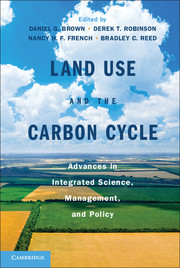Book contents
- Frontmatter
- Contents
- Chapter Authors and Affiliations
- Acknowledgments
- Acronyms
- Part I Introduction
- Part II Measurement and Modeling
- Part III Integrated Science and Research Applications
- Part IV Land Policy, Management, and the Carbon Cycle
- Part V Synthesis and Future Directions
- 20 Forests, Carbon, and the Global Environment: New Directions in Research
- 21 Ecosystem Sustainability through Strategies of Integrated Carbon and Land-Use Management
- 22 Perspectives on Land-Change Science and Carbon Management
- Index
- Plate Section
- References
20 - Forests, Carbon, and the Global Environment: New Directions in Research
Published online by Cambridge University Press: 05 February 2013
- Frontmatter
- Contents
- Chapter Authors and Affiliations
- Acknowledgments
- Acronyms
- Part I Introduction
- Part II Measurement and Modeling
- Part III Integrated Science and Research Applications
- Part IV Land Policy, Management, and the Carbon Cycle
- Part V Synthesis and Future Directions
- 20 Forests, Carbon, and the Global Environment: New Directions in Research
- 21 Ecosystem Sustainability through Strategies of Integrated Carbon and Land-Use Management
- 22 Perspectives on Land-Change Science and Carbon Management
- Index
- Plate Section
- References
Summary
Introduction
At this time, there is a convergence between two related and serious global concerns: (1) the emerging climate crisis brought on by fossil fuel combustion and land-use change and (2) an economy reliant on increasingly scarce and nonrenewable fossil fuels for energy and materials. Both of these concerns are pushing science and policy to begin discussing and understanding the implications of a future economy in a carbon (C)-constrained world, where both opportunities and challenges abound (World Economic Forum 2009). The two concerns are related. First, there is clear evidence that climate change is caused by the human use of fossil C (for energy and feedstock for materials, such as plastic) and deforestation (IPCC 2007b). In turn, climate change has potentially profound effects on C storage in agriculture and forests. The need to mitigate climate change has created political and policy pressure to reduce the use of fossil C through the development of renewable fuels and materials from biological feedstocks, mostly from land-based biomass in crops and forests (IPCC 2007a). In addition, land dedicated to agriculture that is threatened by climate change will be increasingly threatened by competition to grow biomass feedstocks (Rathmann, Szklo, and Schaeffer 2010). Indeed, some common crops used traditionally as a food source are being reengineered for fuels: corn, soybeans, oil palm, and sugarcane, to name a few (Naylor et al. 2007). Moreover, land once devoted to agriculture is increasingly being converted to nonagricultural biomass for fuel and materials. Natural forests are being converted to biofuel feedstock plantations (Danielsen et al. 2008). Therefore, the two concerns are intimately related to land-use change and its relationship to the C cycle.
- Type
- Chapter
- Information
- Land Use and the Carbon CycleAdvances in Integrated Science, Management, and Policy, pp. 505 - 522Publisher: Cambridge University PressPrint publication year: 2013
References
- 5
- Cited by



